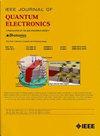建模 3 微米级掺铒氟化物光纤激光器的立方能量传输速率依赖性
IF 2.2
3区 工程技术
Q3 ENGINEERING, ELECTRICAL & ELECTRONIC
引用次数: 0
摘要
我们提出了一种具有立方原子群依赖性的能量传递模型,以精确模拟各种已报道的在 2.8 微米附近工作的高功率掺铒氟化物光纤激光器的行为。我们首先表明,之前引入的弱相互作用(WI)和强相互作用(SI)模型不足以精确模拟此类大功率掺铒氟化物光纤激光器。我们通过模拟先前在文献中报道的 4 种不同的高掺杂(7 mol.%)光纤激光器,将 WI 和 SI 模型获得的结果与所提出的模型进行了比较。激光效率和功率都得到了非常精确的再现。此外,使用所提出的模型和完全相同的光谱参数集,还精确地模拟了铒浓度为 1-6 摩尔%的其他四种光纤激光器系统,这证实了该模型对各种铒掺杂浓度的有效性。通过考虑全截面光谱和计算多个波长通道的信号功率,还考虑了激光波长的红移。本文章由计算机程序翻译,如有差异,请以英文原文为准。
Modeling the 3-Micron Class Er-Doped Fluoride Fiber Laser With a Cubic Energy Transfer Rate Dependence
We propose an energy transfer model with a cubic atomic population dependence to accurately model the behavior of various reported high-power erbium-doped fluoride fiber lasers operating near 2.8 microns. We first show that the previously introduced weakly interacting (WI) and strongly interacting (SI) models are not adequate for precisely modeling such high-power erbium-doped fluoride fiber lasers. We compare results obtained with the WI and SI models to the proposed model by simulating 4 different highly doped (7 mol.%) fiber lasers previously reported in the literature. Laser efficiencies and powers are reproduced with great accuracy. In addition, four other fiber laser systems based on erbium concentrations varying from 1–6 mol.% are also simulated with good accuracy using the proposed model with the exact same set of spectroscopic parameters, which confirms its validity for various erbium doping concentrations. Redshifting of laser wavelength is also taken into account by considering the full cross section spectra and computing signal powers over several wavelength channels.
求助全文
通过发布文献求助,成功后即可免费获取论文全文。
去求助
来源期刊

IEEE Journal of Quantum Electronics
工程技术-工程:电子与电气
CiteScore
4.70
自引率
4.00%
发文量
99
审稿时长
3.0 months
期刊介绍:
The IEEE Journal of Quantum Electronics is dedicated to the publication of manuscripts reporting novel experimental or theoretical results in the broad field of the science and technology of quantum electronics. The Journal comprises original contributions, both regular papers and letters, describing significant advances in the understanding of quantum electronics phenomena or the demonstration of new devices, systems, or applications. Manuscripts reporting new developments in systems and applications must emphasize quantum electronics principles or devices. The scope of JQE encompasses the generation, propagation, detection, and application of coherent electromagnetic radiation having wavelengths below one millimeter (i.e., in the submillimeter, infrared, visible, ultraviolet, etc., regions). Whether the focus of a manuscript is a quantum-electronic device or phenomenon, the critical factor in the editorial review of a manuscript is the potential impact of the results presented on continuing research in the field or on advancing the technological base of quantum electronics.
 求助内容:
求助内容: 应助结果提醒方式:
应助结果提醒方式:


